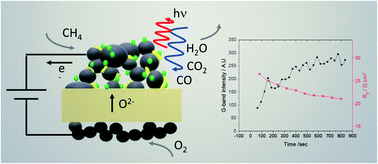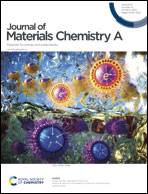Operando characterization of metallic and bimetallic electrocatalysts for SOFC fuel electrodes operating under internal methane reforming conditions
Abstract
Linear sweep voltammetry (LSV), electrochemical impedance spectroscopy (EIS) and operando Raman spectroscopy were used to study the electrochemical performance and carbon tolerance of SOFCs operating with niobium doped SrTiO3 (STN) anodes infiltrated with combinations of Ni, Co, and Ce0.8Gd0.2O2 (CGO) added to improve catalytic activity. Cell anodes were exposed to fuel feeds of humidified H2, pure CH4 and combinations of CO2 and CH4 at an operating temperature of 750 °C. Under pure CH4, Raman data show that carbon forms on all anodes containing Ni. In cells with CGO, deposited carbon results in a decreased polarization resistance. This behavior may be due to benefits conferred by CGO to the electrocatalytic activity of triple phase boundaries, presumably through improved oxide ion conductivity and/or due to carbon securing a better electrical connection in the electrodes. Raman spectra from Co-only containing anodes show no sign of carbon deposition. The absence of observable carbon together with low frequency processes observed in the EIS suggest that Co may play a role in oxidizing carbon before measurable amounts accumulate.

- This article is part of the themed collection: Special issue in honour of Prof. John Kilner’s 75th birthday


 Please wait while we load your content...
Please wait while we load your content...